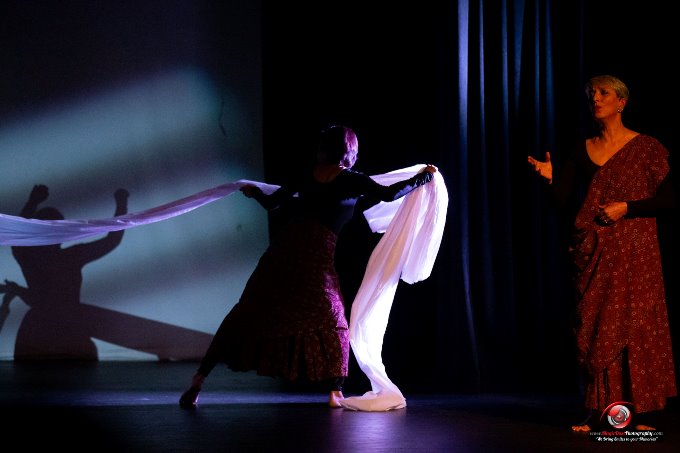Interviews: MALLIKA SARABHAI: Powering Change through the Performing Arts, & SAMIA MALIK, the Voice Behind the Stories
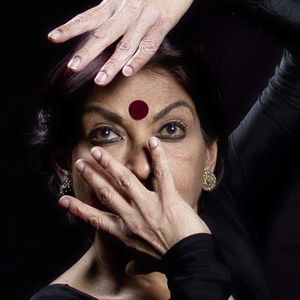
Danseuse, activist, actor, publisher, and writer—Mallika Sarabhai has worn many hats through the course of her illustrious career. The common thread, though, that runs through all her endeavors is a unique form of social activism. Leveraging her mastery of the performing arts, Mallika has over the years attempted to shake up the status quo, challenge antiquated patriarchal traditions, and tirelessly advocate for feminism and other causes dear to her heart. Currently on a tour in the U.S., Mallika chatted with Khabar about her personal journey through the arts, her family, her stint with national politics, and much more.
“I was a lazy child,” she reminisces with a hint of wry humor, and it’s all one can do to not let the jaw drop in disbelief. After all, Mallika Sarabhai is known today as the relentless and tenacious Renaissance woman who is using her art form to impact society for the better. Her decades of work have made a significant contribution to modern India’s art and cultural scene.
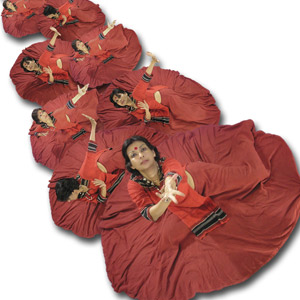
“Colours of her Heart,” the title of her dance-drama may refer to women in general, but also to Mallika specifically, considering the labor of love that the production has been for her. (Photo: courtesy, Darpana Academy of Performing Arts)
Mallika was recently in Atlanta for a fundraiser hosted the Sheth Family Foundation and Paddy Sharma. The event, which was organized and sponsored by Narayan Seva Sansthan and several other associations and individuals, was the world premiere of the 2019 version of “The Colours of Her Heart,” a show that she says is “is a plea to heal the world of gender wars.”
“Atlanta was our first venue in the U. S. for this release and there could not be a better venue to start with—the birthplace of Dr. Martin Luther King, Jr. and his Civil Rights agitation. This is an interesting tour where we present at museums like the Smithsonian and the Peabody and in universities like Harvard and Vassar. Likewise we have had many presentations in the past at universities and educational campuses. That is where change sparks. It ignites the young and that is what building a better nation [and] world, is all about.”
Indeed, building a better nation and sparking change has been the leitmotif of Mallika’s astonishingly prolific life and career. Perhaps it was meant to be so? Mallika was born to illustrious parents whose careers spanned business, the arts, and science. Her father, Vikram Sarabhai, was a pioneering industrialist who went on to found India’s flagship space institute Indian Space and Research Organization (ISRO) as well as the renowned Indian Institute of Management (IIM), Ahmedabad. Her mother, Mrinalini Sarabhai, was one of India’s most revered Bharatanatyam exponents. Together, the Sarabhais founded the now iconic Darpana Academy of Performing Arts (Ahmedabad) in 1949, offering regular courses in the Indian classical dance styles of Bharatanatyam, Kathakali, and Kuchipudi, Carnatic vocal, instruments like flute, violin, and mridangam, puppetry, and the Indian martial arts form Kalaripayattu.
The extended Sarabhai family was no less accomplished— Gautam Sarabhai, Vikram’s brother, remained an industrialist and founded India’s foremost design school, National Institute of Design (NID), while his sister Mridula Sarabhai was a freedom fighter and a politician.
“Both my parents were building a nation. One used the arts, the other used science,” says Mallika, very matter-of-factly. Likewise, “My brother and I are committed to continue the building of a better India and a better world, and I think that’s where all four of us converge. We took different paths to it. My brother’s an environmentalist. All of us have spent our lives to try to better societies, in one way or the other.”
From managing and expanding the activities of Darpana Academy of Performing Arts, producing and dancing in her own shows, acting on stage and films, publishing, social activism, and a brief stint in politics, Mallika’s life has followed a brilliant trajectory across India’s sociocultural landscape. She is among the more visible flagbearers of the feminist movement in India, using the medium of performing arts to narrate stories of women, to prize apart deeply entrenched patriarchal norms, and advocate new, open ways of thinking about women’s roles in society.
Coming from a liberal family who allowed her the freedom to explore her chosen paths to personal fulfilment, Mallika believes that seeing and hearing of the contributions made by her larger family led to her becoming “an activist before I could fully understand was activism is.”
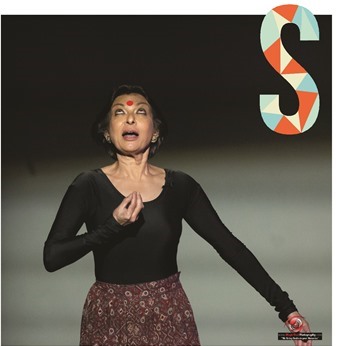
In ‘Colours of her Heart,’ which Mallika describes as “a plea to heal the world of gender wars,” she is in her element—using her prodigious talent in the evocative art form of Bharatnatyam to tug at the audiences’ hearts. (Photo: Jasveer & Hemant Shah, magicdustphotography.com)
Her concern with the issue of gender is twofold, and much of her work over time has been dedicated to highlighting the gender fault lines in society. “[Boys] are raised to “not cry” but “be a man,” to not feel and to not have any natural human emotional qualities…. “Be a man” is probably the most disastrous words you can speak to your growing son. Since he is trained “not to cry,” he lets out [emotions] in a myriad of negative ways, such as drugs, anger, deep hatred, etc. Correspondingly, girls are raised in the strictest environment, restricted in so many ways suppressing their needs and wants, conforming to their caste and religion with dress code restrictions, behavior restrictions, etc. At some stage they are transplanted from their parent’s home to their husband’s, expecting pretty much the same. Their voice remains unheard in most cases—doing the greatest harm to our society and to the modernized world.”
Mallika believes that it’s the urban public—and women in particular—who need to critically examine their lives. “The rural woman across the world, albeit lesser educated, knows that she has to fight for her existence—her rights, since she toils the fields in the day, cooks, and takes care of her kids and so on, whereas the urban woman thinks that because she is educated, and dressed in modern clothes, carrying a branded handbag, that she is liberated. Frankly, she is not! She is the one that is confined to the morality of her society peers and pretends what is acceptable to them, including her spouse and other males, is okay with her. It is the educated that need help to find their true freedom since they are in shackles—just prettier ones. They need to raise their kids free of gender, religion, nationality, wealth, and all other biases that tie them down. It is for them that I have to wage this dialogue on a war footing.”
Another widely prevalent social malaise that disturbs her strongly is the human tendency worldwide to perceive the complexities of life from a binary perspective—male-female, black-white, rich-poor, and urban-rural, to name a few—a deeply flawed outlook that engenders prejudice, hatred, exclusion, and discrimination. “That is not what real life is!” she says emphatically. Her art strives to address these issues in a way that engages audiences in a deeply emotional way. Therefore, her art can be “entertaining, but certainly is not entertainment. I work to put art back at the center of life, as a meaningful reflection on life.” In ancient Indian culture, she says, the varied genres of art—classical or tribal or folk—had a purpose deeper than mere entertainment. “Music, dance, poetry, or even the arts on canvas or statues … always influenced the society or suggested reform.”
Mallika’s passion for excellence, her strong beliefs, and tenacity notwithstanding, how easy or difficult is it to draw audiences in an India that’s besotted with commercially produced entertainment? Mallika’s response reflects her practical grasp of social realities. “Although my work is for general audiences—young, old, all genders—we do not expect hundreds of thousands to attend as the appeal is largely on a one-to-one basis. The fact that we get attendees is because we have been able to combine entertainment with a strong social message. There is something that happens with live performance that is special. The voice we create and present remains with the attendee for a lot longer than after the show ends. It stays with them. If we can alter the thought process of the few that attend, they will share and talk and influence others.”
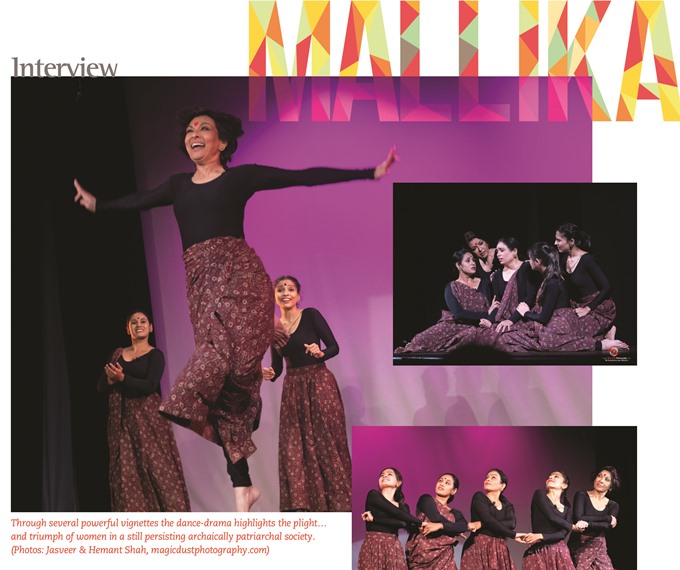
Through several powerful vignettes the dance-drama highlights the plight… and triumph of women in a still persisting archaically patriarchal society.
The impact of her theatrical productions—and their embedded values—has not gone unnoticed. “Sita’s Daughters” so impressed Sharad Pawar, the then Chief Minister of Maharashtra, that he passed an order that all sitting judges in Maharashtra must watch the production. Similarly, says Mallika, “All students at Shreemati Nathibai Damodar Thackersey Women’s University (SNDT) in Mumbai—the largest women’s university—for years were expected to see and write about the performance. That is what we expect from of our performances—transformative change in the viewers, who then become change agents themselves.”
Looking back at Mallika’s personal engagement with the performing arts, one would assume that she took to Bharatanatyam by default, considering that her guru was her mother, the lovely and graceful Mrinalini Sarabhai. No such thing, says Mallika. “It was just that even by the time I was five years old, every single one of my friends went to Darpana to learn Bharatanatyam and I was the only one who didn’t. There was nobody during those hours to play with, so I thought I might as well join the class! My parents never defined what to or not to follow as a rigor, and we were presented bountiful choices as children. My first professional journey was into puppetry, not even theatre or dance. At 11, I joined Darpana’s puppet group and started touring with them—a little known part of my life. And I was not encouraged to learn Kuchipudi till I had perfected Bharatanatyam—the two can easily be mixed up.” In 2000, Mallika was awarded the Sangeet Natak Akademi Award for Creative Dance.
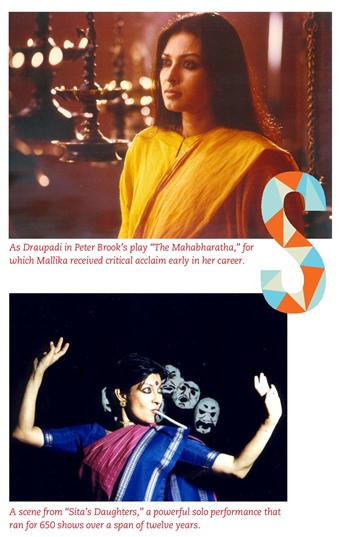
Theatre, and later, film acting too, have been an organic part of her growth. “Because Darpana had all aspects of the arts, I just naturally went into learning everything. Nobody told me that you should become an expert in one and not in the others. I think it was one of those happy coincidences that I just fell into learning it all,” recalls Mallika.
Perhaps her most notable and critically acclaimed role is as Draupadi in Peter Brook’s “The Mahabharata,” an international 12-hour production that toured the world from 1984 till 1990. Some of her other notable works include “Unsuni,” the story of India’s marginalized, “Ahmedabad Ki Aurat Bhali—Ramkali,” an adaptation of “The Good Person of Szechuan,” and “Shakti: The Power of Women,” a work on the image of Indian women. Her play “Sita’s Daughters” has traveled the world and been performed in excess of 500 shows, in three languages.
Mallika has acted in over 30 films in English, Gujarati, and Hindi. Were films a natural progression from theatre? Again, Mallika’s response is anything but expected! “I was a lazy child, and dancing was too much hard work. But I love being center stage and films came early, so I joined when I was fifteen,” she says. Notwithstanding her talent and electric good looks, success and recognition proved elusive at first. “My first three films didn’t get released because they were avant garde. I got awards for them but they never saw the light of day!” she says candidly.
Despite having many admirers and encouraging friends from the Bombay film industry, Mallika simply could not find a fit with the stereotyped roles that Bollywood offered. Fed up with the crass commercialism that ruled the industry, she abandoned Hindi films. Ten years on, she returned, but this time to Gujarati films. Her Mena Gurjari (1975) for which she won a Best Actress award became the longest running Gujarati film of all time.
Along the way, Mallika also delved into writing, her work spanning scripts for films, TV serials, shows and ISRO’s educational show. She continues to be a contributor to several popular publications. Another feather in her cap was the debut of Inside Outside, India’s first design magazine. Together with ex-husband Bipin Shah, she runs Mapin Publishing, bringing out a range of books that showcase Indian cultural traditions and social diversity.
Social change being the driving force behind much of her work, Mallika could not possibly ignore the option of entering into politics. She gave that a shot, too, as an independent candidate but lost in the Parliamentary elections of 2009. It was a brief and disillusioning journey.
Speaking of the experience with her trademark frankness, she says, “I had to reconcile to the fact that election in India is a process only for established parties that breed on corruption, casteism, and control. I began with the notion that if I had just 200 individuals with a strong desire to bring change, as our designed constitution allows for, then I would need them to give me seven years of their time. The first two years for planning grassroots changes and the drafting of such policies, and the other five to govern for one term. Since we [would] not be scratching anyone’s backs, our backs wouldn’t be scratched either, and we wouldn’t expect to return for another term as we would have been extremely disruptive to the norm by then. At elections, I had villagers come and speak with me, pointing out the goondas standing on the wayside in a hostile manner, preventing them [from voting] for me, [although] it was their desire to bring reform to their locale. After spending some time continuing to discuss the possibilities, I soon realized that I was the last woman standing and did not have the wherewithal to take on the establishment of saturated political parties with no agenda, as an independent candidate, again.”
Defeat though, is not a word that exists in Mallika’s vocabulary. India’s political establishment failed to leverage her dedication to nation building, but her extraordinary credentials and sheer hard work have attracted attention from other quarters. Mallika has served the United Nations and its ancillaries through varied programs. She has actively participated with UNICEF’s Peer Education Projects, Anandshala Project, Fatehpura Model Village Project and Rural Health Project. Elaborating further, she says, “I have designed international programs and worked with nations like Australia and France, besides India and the U.S. Darpana offers Artist Residency Programs under the aegis of UNESCO.”
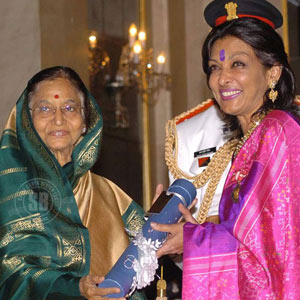
Receiving the Padma Bhushan from President Pratibha Patil (left), in 2010.
Internationally, Mallika has been feted as much for her artistic excellence as her social activism. “France bestowed on me the Etoile D’Or honor in 1977, which is [their] highest dance award, and the civilian award, Chevalier de l’Ordre des Arts et des Lettres, just like I was presented the Padma Bhushan in 2010 by the President of India, for my contribution to Performing Arts.” She wears these honors lightly, saying philosophically, “As far as our karma is concerned, people often lose sight that [the] beloved and free spirited Krishna who belonged to Gokul, is the same disciplined warrior and strategist in the Mahabharata. Therefore, we, too, have the responsibility of employing all our facets, all our personalities, and not [be] forced to operate only the one.”
Looking at Mallika’s enormous appetite for work and reinventing herself, the question inevitably arises—what drives her to push herself, to excel in all she does? Surely, not just her DNA? Pat comes the answer, laced with her trademark bluntness. “I think it’s just bloody-mindedness and working very, very hard. My mother always used to say that it’s 99 percent perspiration and 1 percent inspiration. And people ask me today, why do you still rehearse? I always say that the older one gets, the more one needs to rehearse to keep up to that standard. And I think the one thing that I do is I work very hard. I set the highest standards for myself rather than for others and therefore I can show by my own work that when I demand something of others, I am equally demanding even more so of myself. So I think it’s really like a dog going after a bone and loving it. I’m enjoying every moment,” says Mallika.
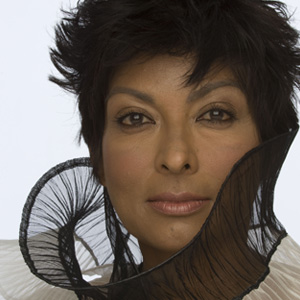
A versatile woman, Mallika effortlessly traverses between tradition and modernity. (Photo: Rafiq Saiyyad, from Darpana Archives).
Surely, a lifetime of hard work and so many accomplishments in the pursuit of social change deserves to be chronicled for posterity? Mallika is emphatic that it is not for her to preserve her legacy. “I am working in the now and have no fear if I will be forgotten the day I am gone. I am so severely busy, and there is such an urgency in the work I do to bring about that change before time runs out. That time is now. Therefore it is not a paramount issue for me. However, if someone desires to take the time and record the narrative since time known, I have no objections!”
Moreover, says Mallika, “Maybe after a decade or so of doing this, the world will change and we may have to find another cause to support. We strongly desire that our work would be done, but that is certainly not the case. Albeit as a society we feel we are progressive, but in effect we have regressed many folds more than the times [in which] our ancient predecessors lived. We have first generation mothers and grandmothers who saw our productions and who want us to revive the same so that their clueless daughters and granddaughters get to see and experience the same and hopefully learn from it!”

|
On patriarchy:
On popular culture:
On today’s students and dance schools: Gone are the days when arts, poetry, music, literary works, et al. inspired a generation to impact social change. Now it’s the time of instant gratification and immediate success—no one wants to labor for it and achieve the accolades. Especially dance students. Can one play tabla for a couple years and tell Ustad Zakir Hussain that he/she plays tabla like him? Or can a sitar student tell Ustad Ravi Shankar the same? But with dance, that liberty exists—and it should not. The umpteen number of dance schools sometimes do a disservice by allowing their students—based on their urgency to graduate—[to] adopt a fast track schedule, to complete a fixed number of items, to certify their completion of training in that specific discipline, and call themselves dancers.
Darpana’s vision:
A message to aspiring artistes: |
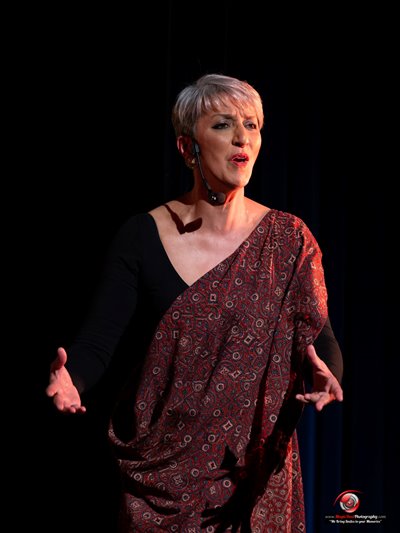
(Right) Samia Malik performing her songs during "The Colours of Her Heart" program on March 8, 2019 in metro Atlanta. (Photo: Magic Dust Photography)
Conversation with Samia Malik, the voice behind the stories.
A Pakistani born and now a UK resident, singer-reformist Samia Malik grew up in a devout but quasi liberal Islamic family. The middle child, she recalls her father loving her to the hilt, but when her father died tragically young, she was left with no male authority to protect and support her, in a culture where women have little power.
Although she has worked with Mallika Sarabhai over the years, her motivation comes from earlier, from a background which was much more restricted. After having moved to the UK at a very young age of 6, she was not introduced to the fine arts but was deeply in love with music, a talent she pursued much later in her late twenties, as a single mother raising a family. Then, in an effort to discover her voice (pun intended) she became the enabler of discovering the voices for others, lending her lyrics, her songs, and her voice to narrate their tales in music and letting them heal, one bit at a time.
“We both [Mallika and I] come from the same geography and similar cultures albeit very different environments. Nothing changes unless you make the change, and the change starts within, not without! Enough tears have flown, enough blood has been shed, but if we are able to reform our inside for what is right and what is just, and live our lives without fear, then no one entity can govern us, confine us to do what they want us to, or take away our freedom. The inner voice needs to be developed and surged forward to express. We have only one life to live.”
When did you begin your quest for singing?
In England, I was in search of a vocalist guru who could bring out the music in me, which I felt deeply inside but did not know how to express, as we were conditioned and not allowed to. So when I found the one, Guru Baluji Shrivastav, OBE (Order of the British Empire), whom I desired to train under and who is a noted teacher, I reached out.
At our first meeting he asked me to sing, sing anything at all. I did and he then asked me to sing again and after a few such endeavors he asked me, “Who did this to you?” What he meant was, why was my voice not audible, although it had musicality? It couldn’t be heard as I was conditioned to not be heard, so I had the toughest time to have my voice project. But over two decades later and still training with the same guru, now I can sing out loud.
Although I did not come from a gharana, nor was anyone in my family a singer of any note, I sang in the traditional ghazal format, and I thoroughly enjoyed it. I developed that voice and felt that it could lend credence by singing of social norms that I did not reconcile with in the past.
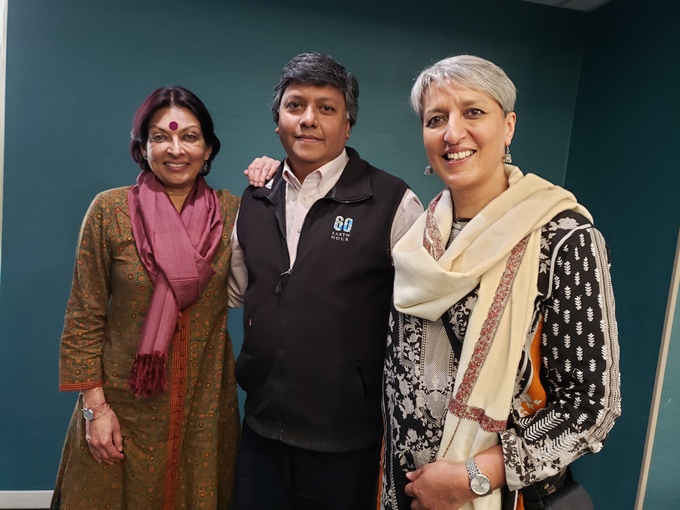
Padma Bhushan Mallika Sarabhai, interviewer Viren Mayani, and singer-reformist Samia Malik in Atlanta before the March 8, 2019 "Colours of Her Heart" program.
As luck would have it, I was at a Mallika presentation and thoroughly enjoyed it. But we did not speak, as I was still within myself, not out. This happened a couple of times over the years and we had still not connected. It became difficult as I had not shared my contact with her and it was for a long while that we had not even seen each other. And finally we were connected, and now we have had a chance to work together for over a decade, and we enjoy each other’s talents and work produced in a similar vein.
I just landed today [the day of the interview was before the March 8, 2019 “Colours of Her Heart” program in metro Atlanta] and have been seeing the work videos sent over by Mallika to me. Soon I will have transferred my lyrics and songs over the presentation and it will become one work cohesively produced—very fresh, very new, and a very organic performance to say the least.
Interestingly, although I have now become a reformist-singer of repute, my mother still does not know how to celebrate my success or handle the situation! She still struggles about the content that I create music on, because I write about the truth and some of it is very uncomfortable to bear, talk about, or support.
If, for hyperbole’s sake, you were to take this work back to your roots, what would be the reaction?
Well, it’s not just about now but even when my work was getting noticed, people would state, “How can you be rendering ghazals? You are not from a gharana. Your hair is so short and you have an English accent. You are completely nonconformity, so how can you call it traditional?” And so on… But I have presented and will continue to do so at every available opportunity. The fact remains that the inner voice needs to be identified and nurtured so that it can sing the tales of the many, in similar and yet more archaic situations. Bondage of women is a global issue, it just takes different shapes.
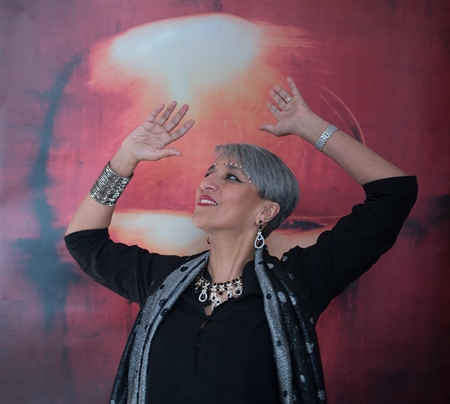
(Photo: Courtesy of Samia Malik)
What is one of your favorite and noteworthy performances?
“Azaadi Freedom.” It is about the unheard women’s voices and the liberation that one feels when the voice is developed. Again, it is freedom from within as there is no external entity that controls us or conditions us, it is the fear instilled in us and a tool with which external forces outside of you govern you. Azaadi is about freedom from that fear which has been housed within for so many years and which has been passed on as legacy from one woman to another. The effort in searching out your own truth, which leads to freedom, is emancipating. “Janam ke dukh mein kyon padi ho, Maut ki khushi mein gaya karo. Chaar din ki zindagi he, Gaa ke dil behlaya karo.” (Why are you moaning the pain of your life, death will soon end it—so rejoice. Life is four days long, sing and celebrate your heart till then.)
When you are thinking of penning such words for your lyrics, and because you are multicultured, do you think in Urdu or English?
Generally when I write, it is in Urdu so my thoughts are in Urdu as well, because I sing in the ghazal format. It comes more naturally and easily. Besides, my Urdu is simple. I did not begin writing or doing music until I was twenty-some, and I was a bit surprised myself that I was writing in the ghazal format. I realized that I was who I was culturally, even though I had been in England since I was 6—that thousands of years of my culture was somewhat buried deep in me.
However my Urdu has become rusty as there aren’t enough people of my culture to speak Urdu with, and also because some of my songs are in English I have begun thinking in English and writing as well. Currently it’s fusion. When you move at such a young age and change nations, there are issues surrounding your identity. I am a Pakistani growing up in England and that is a very different experience—it’s quite specific. Issues about language, belonging…. displacement is a massive issue of our times. In one of my songs I write, “Where should I look for my gods and what language shall I sing in?”
One thing that both of us learned of each other when we first met [Mallika and I] was that we were both fans of the poet Kishwar Naheed, a feminist, who wrote very strong political Urdu poetry. So my first compositions were from a book of English translations of her works. I loved it because it was about Pakistani women’s experiences in Pakistan. But I wanted to write about how it feels to be from that background and grow up in the UK. I think people relate to my work because it comes directly from my experience and my heart.
|
|
| Samia Malik (far right) sings for the "One City" dance during "The Colours of Her Heart" performance. (Photo: Magic Dust Photography) |
Viren Mayani is a finance executive by profession, a prominent liaison in the Atlanta Indian community, and a musician. He is a senior contributor at Khabar who frequently interviews leading personalities in arts, entertainment, business, and politics.
Enjoyed reading Khabar magazine? Subscribe to Khabar and get a full digital copy of this Indian-American community magazine.
blog comments powered by Disqus




